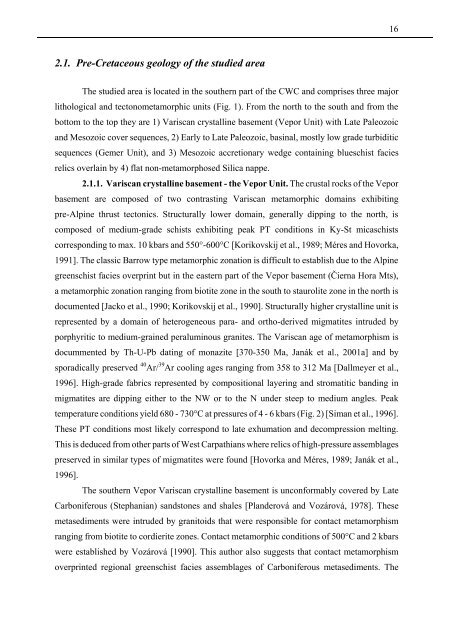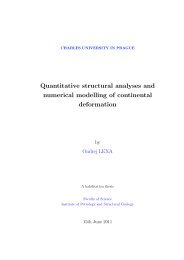PhD. thesis - Univerzita Karlova
PhD. thesis - Univerzita Karlova
PhD. thesis - Univerzita Karlova
You also want an ePaper? Increase the reach of your titles
YUMPU automatically turns print PDFs into web optimized ePapers that Google loves.
2.1. Pre-Cretaceous geology of the studied area<br />
The studied area is located in the southern part of the CWC and comprises three major<br />
lithological and tectonometamorphic units (Fig. 1). From the north to the south and from the<br />
bottom to the top they are 1) Variscan crystalline basement (Vepor Unit) with Late Paleozoic<br />
and Mesozoic cover sequences, 2) Early to Late Paleozoic, basinal, mostly low grade turbiditic<br />
sequences (Gemer Unit), and 3) Mesozoic accretionary wedge containing blueschist facies<br />
relics overlain by 4) flat non-metamorphosed Silica nappe.<br />
2.1.1. Variscan crystalline basement - the Vepor Unit. The crustal rocks of the Vepor<br />
basement are composed of two contrasting Variscan metamorphic domains exhibiting<br />
pre-Alpine thrust tectonics. Structurally lower domain, generally dipping to the north, is<br />
composed of medium-grade schists exhibiting peak PT conditions in Ky-St micaschists<br />
corresponding to max. 10 kbars and 550°-600°C [Korikovskij et al., 1989; Méres and Hovorka,<br />
1991]. The classic Barrow type metamorphic zonation is difficult to establish due to the Alpine<br />
greenschist facies overprint but in the eastern part of the Vepor basement (Čierna Hora Mts),<br />
a metamorphic zonation ranging from biotite zone in the south to staurolite zone in the north is<br />
documented [Jacko et al., 1990; Korikovskij et al., 1990]. Structurally higher crystalline unit is<br />
represented by a domain of heterogeneous para- and ortho-derived migmatites intruded by<br />
porphyritic to medium-grained peraluminous granites. The Variscan age of metamorphism is<br />
docummented by Th-U-Pb dating of monazite [370-350 Ma, Janák et al., 2001a] and by<br />
sporadically preserved 40 Ar/ 39 Ar cooling ages ranging from 358 to 312 Ma [Dallmeyer et al.,<br />
1996]. High-grade fabrics represented by compositional layering and stromatitic banding in<br />
migmatites are dipping either to the NW or to the N under steep to medium angles. Peak<br />
temperature conditions yield 680 - 730°C at pressures of 4 - 6 kbars (Fig. 2) [Siman et al., 1996].<br />
These PT conditions most likely correspond to late exhumation and decompression melting.<br />
This is deduced from other parts of West Carpathians where relics of high-pressure assemblages<br />
preserved in similar types of migmatites were found [Hovorka and Méres, 1989; Janák et al.,<br />
1996].<br />
The southern Vepor Variscan crystalline basement is unconformably covered by Late<br />
Carboniferous (Stephanian) sandstones and shales [Planderová and Vozárová, 1978]. These<br />
metasediments were intruded by granitoids that were responsible for contact metamorphism<br />
ranging from biotite to cordierite zones. Contact metamorphic conditions of 500°C and 2 kbars<br />
were established by Vozárová [1990]. This author also suggests that contact metamorphism<br />
overprinted regional greenschist facies assemblages of Carboniferous metasediments. The<br />
16







